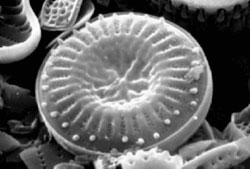What are Bacillariophyta?
 Bacillariophyta are diatoms. All diatoms are single-celled organisms. They are microscopic, glassy organisms that photosynthesize for food, like plants. Diatoms live in the sediments of freshwater, such as lakes, and in marine environments, such as the ocean. Diatoms are also called microfossils, because of their size and because they date all the way back to the Cretaceous period of the Earth, which is about 144 to 65 million years ago!
Bacillariophyta are diatoms. All diatoms are single-celled organisms. They are microscopic, glassy organisms that photosynthesize for food, like plants. Diatoms live in the sediments of freshwater, such as lakes, and in marine environments, such as the ocean. Diatoms are also called microfossils, because of their size and because they date all the way back to the Cretaceous period of the Earth, which is about 144 to 65 million years ago!
Diatoms are known for their 'glass shells'; the shells are actually made of silica. Diatoms secrete these intricate shells that actually fit together, like a Petri dish. There are two sides to the shell; the epitheca actually covers the hyptheca, like a lid. You can only see the many beautiful designs of diatom shells underneath a microscope; they look like tiny jewels!
Some diatoms float freely with microorganisms, such as plankton, in their water environments. They may also attach to crustaceans, turtles or aquatic plants. There are two types of diatoms, classified by the shape of their shells. Centrate diatoms are radially symmetrical and mostly live in marine environments. Freshwater environments are dominated by pennate diatoms, which are bilaterally symmetrical. They serve as an important food source for many organisms.
About the Author
Rebekah Shaffer
 Rebekah Shaffer is currently a Junior at Slippery Rock University, PA. She is pursuing her B.S. in Biology, minor in Chemistry. She currently works as a microbiology lab assistant at Slippery Rock University and is a member of Beta Beta Beta Biology Honorary Society. She plans to obtain her Ph.D. in Molecular/Cellular Biology after completing her undergraduate degree.
Rebekah Shaffer is currently a Junior at Slippery Rock University, PA. She is pursuing her B.S. in Biology, minor in Chemistry. She currently works as a microbiology lab assistant at Slippery Rock University and is a member of Beta Beta Beta Biology Honorary Society. She plans to obtain her Ph.D. in Molecular/Cellular Biology after completing her undergraduate degree.


